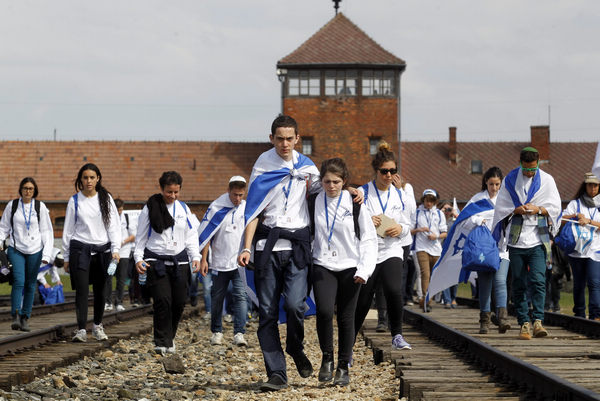Death camp exhibit opens in Shanghai
Updated: 2012-04-27 07:29
By Shi Yingying in Shanghai (China Daily)
|
||||||||
Almost 70 years after the liberation of the largest Nazi-era concentration camp, Poland's Auschwitz-Birkenau State Museum has brought an Auschwitz exhibition to China for the first time to give Shanghai residents a clear understanding of the horrors of the "death camp".
Along with 30 display boards illustrating acts of brutality committed by Nazi soldiers came Jewish people's thanks to Shanghai for its offer of refuge to Jews fleeing Nazi persecution in the 1930s.
|
 |
|
A group of youths are among the thousands participating in the "March of the Living" at the site of former Nazi death camp Auschwitz, in Poland on April 19. Provided to China Daily |
"This is what would happen to Jews who weren't lucky like those saved by the people of Shanghai during World War II," said Miroslaw Obstarczyk, curator of Auschwitz-Birkenau State Museum's exhibition department.
Auschwitz, built after the Nazis invaded Poland in 1939, was the largest of Adolf Hitler's concentration camps. It included three main camps and 45 satellite camps. Rudolf Hoss, the death camp's first commandant, testified after the war at the Nuremberg trials that up to 3 million people died there, 2.5 million of them gassed, the others succumbing to disease and starvation - the actual figures will never be known, but today it is thought that 1.3 million people died at Auschwitz and more than 90 percent of them were Jews.
According to Krzysztof Smyk, consul general of Poland in Shanghai, pre-war Jewish Poles constituted about 10 percent of the country's population and more than 25 percent of them were artists, writers, lawyers and doctors. "Almost all of them were killed, and many in Auschwitz, where thousands of Poles and other European non-Jews also lost their lives," Smyk said.
The help Shanghai offered was a ray of hope to the Jewish people at that time. The city received nearly 30,000 Jewish refugees during World War II, and many arrived thanks to Ho Feng Shan, the former Chinese consul general in Vienna, who issued thousands of visas to Shanghai for Jewish refugees.
In the late 1930s, when increasing Nazi pressure to rid their territories of Jews created waves of refugees desperate to emigrate, most Western nations, including the United States, wouldn't open their doors to Jews. Shanghai was the last resort.
When Steven Dwoskin, whose father-in-law survived a Nazi concentration camp, came to the exhibition and heard about Shanghai being a haven for Jews during the war, he said he was overwhelmed. "It's incredible that they (the Chinese) would do this - it's not their people and it's not their problem, it's the world's problem," he said.
According to Chen Jian, the curator of Shanghai Jewish Refugees Museum, where the exhibition is held, the exhibition will be on long-term display. Video records and re-created camp items, such as prisoners' uniforms and cages where prisoners were kept and abused, are also included in the exhibition.
Contact the writer at shiyingying@chinadaily.com.cn

 Relief reaches isolated village
Relief reaches isolated village
 Rainfall poses new threats to quake-hit region
Rainfall poses new threats to quake-hit region
 Funerals begin for Boston bombing victims
Funerals begin for Boston bombing victims
 Quake takeaway from China's Air Force
Quake takeaway from China's Air Force
 Obama celebrates young inventors at science fair
Obama celebrates young inventors at science fair
 Earth Day marked around the world
Earth Day marked around the world
 Volunteer team helping students find sense of normalcy
Volunteer team helping students find sense of normalcy
 Ethnic groups quick to join rescue efforts
Ethnic groups quick to join rescue efforts
Most Viewed
Editor's Picks

|

|

|

|

|

|
Today's Top News
Health new priority for quake zone
Xi meets US top military officer
Japan's boats driven out of Diaoyu
China mulls online shopping legislation
Bird flu death toll rises to 22
Putin appoints new ambassador to China
Japanese ships blocked from Diaoyu Islands
Inspired by Guan, more Chinese pick up golf
US Weekly

|

|







